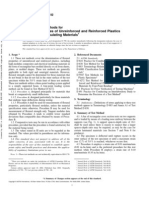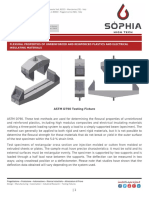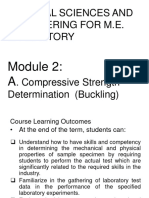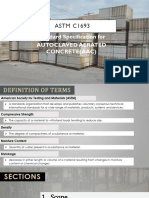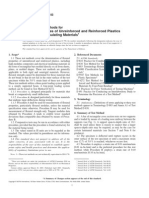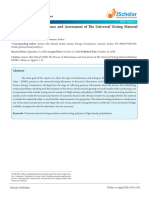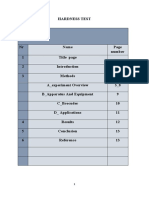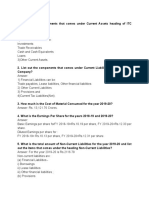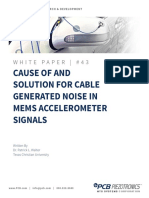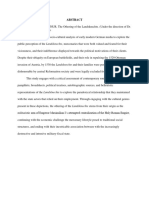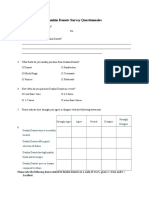0 ratings0% found this document useful (0 votes)
130 viewsASTM D2583 Standard Testing Method of Measuring Hardness by Barcol Hardness Method
ASTM D2583 Standard Testing Method of Measuring Hardness by Barcol Hardness Method
Uploaded by
HASSAN WASEEMThis document summarizes several ASTM testing standards for measuring properties of materials, including hardness, density, durometer hardness, peel resistance, surface/volume resistivity, yellowness index, and refractive index. For each standard, a brief description is given of the property being measured, the test method, and key parameters such as specimen size. Diagrams are included illustrating the testing equipment and procedures. Reference sources from Intertek.com provide more detailed information on the standards.
Copyright:
© All Rights Reserved
Available Formats
Download as DOCX, PDF, TXT or read online from Scribd
ASTM D2583 Standard Testing Method of Measuring Hardness by Barcol Hardness Method
ASTM D2583 Standard Testing Method of Measuring Hardness by Barcol Hardness Method
Uploaded by
HASSAN WASEEM0 ratings0% found this document useful (0 votes)
130 views8 pagesThis document summarizes several ASTM testing standards for measuring properties of materials, including hardness, density, durometer hardness, peel resistance, surface/volume resistivity, yellowness index, and refractive index. For each standard, a brief description is given of the property being measured, the test method, and key parameters such as specimen size. Diagrams are included illustrating the testing equipment and procedures. Reference sources from Intertek.com provide more detailed information on the standards.
Original Description:
astm
Original Title
TESTING 2
Copyright
© © All Rights Reserved
Available Formats
DOCX, PDF, TXT or read online from Scribd
Share this document
Did you find this document useful?
Is this content inappropriate?
This document summarizes several ASTM testing standards for measuring properties of materials, including hardness, density, durometer hardness, peel resistance, surface/volume resistivity, yellowness index, and refractive index. For each standard, a brief description is given of the property being measured, the test method, and key parameters such as specimen size. Diagrams are included illustrating the testing equipment and procedures. Reference sources from Intertek.com provide more detailed information on the standards.
Copyright:
© All Rights Reserved
Available Formats
Download as DOCX, PDF, TXT or read online from Scribd
Download as docx, pdf, or txt
0 ratings0% found this document useful (0 votes)
130 views8 pagesASTM D2583 Standard Testing Method of Measuring Hardness by Barcol Hardness Method
ASTM D2583 Standard Testing Method of Measuring Hardness by Barcol Hardness Method
Uploaded by
HASSAN WASEEMThis document summarizes several ASTM testing standards for measuring properties of materials, including hardness, density, durometer hardness, peel resistance, surface/volume resistivity, yellowness index, and refractive index. For each standard, a brief description is given of the property being measured, the test method, and key parameters such as specimen size. Diagrams are included illustrating the testing equipment and procedures. Reference sources from Intertek.com provide more detailed information on the standards.
Copyright:
© All Rights Reserved
Available Formats
Download as DOCX, PDF, TXT or read online from Scribd
Download as docx, pdf, or txt
You are on page 1of 8
ASTM D2583
Standard Testing method of Measuring Hardness by Barcol Hardness Method
Barcol Hardness is used to determine the hardness of both reinforced and non-reinforced rigid
plastics.
The specimen is placed in the indentor of the Barcol hardness tester, and uniform pressure is
applied to it until the dial indicator reaches its maximum. The penetration depth is translated to
absolute Barcol figures.
Specimens are required to be a minimum thickness of 1/16th of an inch. [1]
Figure 1Barcol Hardness Meter
ASTM D792
Standard Testing Method for Measuring Density and Specific Gravity
A material's density is defined as its mass per unit volume. The mass ratio of a particular amount
of material at 23°C to the same volume of deionized water is measured using specific gravity.
Specific gravity and density are important because plastic is sold by the pound, and a lower
density or specific gravity indicates more material per pound or a greater variety of part weights.
Method A and Method B are the two most common test procedures. Method A, which is the
most popular, can be utilized with sheet, rod, tube, and molded items. Method A involves
weighing the specimen in air before immersing it in distilled water at 23°C and using a sinker
and wire to keep it totally submerged as required. The specific gravity and density are computed.
Specific gravity = a/[(a + w)-b]
a = mass of specimen in air.
b = mass of specimen and sinker (if used) in water.
W = mass of totally immersed sinker if used and partially immersed wire.
Density, kg/m3 = (specific gravity) x (997.6)
[2]
Figure 2 Density Meter
ASTM D2240
Standard Testing Method of Measuring Durometer Hardness and Shore
Hardness
Durometer The relative hardness of soft materials, such as plastic or rubber, is determined by
hardness. The penetration of a specific indentor into the material under specified force and time
circumstances is measured in this test. The hardness value is frequently used to identify or
designate a certain elastomer hardness or as a quality control measure on quantities of material.
First, the specimen is set on a hard, level surface. After that, the instrument's indentor is pressed
into the specimen, making sure it's parallel to the surface. Within one second (or as defined by
the customer) of firm contact with the specimen, the hardness is measured.
The thickness of the test specimens is typically 6.4mm (1/4 in). To attain the 6.4mm thickness,
numerous specimens can be stacked, however one specimen is ideal.
The numbers for hardness are obtained from a scale. The Shore A and Shore D hardness scales
are widely used, with the A scale indicating softer materials and the D scale indicating tougher
materials. [3]
Figure 3 Durometer
ASTM D1876-08(2015) e1
Standard Test Method for Peel Resistance of Adhesives (T-Peel Test)
Using a T-type specimen and a tension testing equipment, this test method is generally used to
determine the relative peel resistance of adhesive bindings between flexible adherends. The test
specimen's bent, un bonded ends must be secured in the tension testing machine's test grips, and
a continuous head speed load must be provided. It is required to make an autographic track of the
load versus head movement or load versus distance peeled. After the initial peak, the peel
resistance across a specific length of the bond line must be determined.
Clamp either end of the t-peel specimen in the universal tester / tension testing machine's
independent test grips. Separate the specimen at a rate of 127 mm (5.0 in) per minute for the
bond line's (5-in.) length.
Specimens are cut to 25.4 mm (1.0 in) long x 300 mm (12 in) wide from a T-peel panel. A total
of ten specimens are examined. [4]
Figure 4 Peel Testing
ASTM D257 or IEC 62631-3-1
Standard Test Method for Surface Resistivity, Volume Resistivity
The resistance to leakage current along the surface of an insulating substance is known as surface
resistivity. The resistance to leakage current across the body of an insulating material is known
as volume resistivity. The smaller the leakage current and the less conductive the material is, the
higher the surface/volume resistivity.
A standard size specimen is placed between two electrodes. For sixty seconds, a voltage is
applied and the resistance is measured. Surface or volume resistivity is calculated, and apparent
value is given (60 seconds electrification time).
Surface and Volume resistivity are calculated.
Surface Resistivity is expressed in ohms (per square)
Volume Resistivity is expressed in ohms - cm [5]
Figure 5 Surface Resistivity Measuring Device
ASTM E313
Standard Test Method for Yellowness Index (YI)
The Yellowness Index is a statistic derived from spectrophotometric data that describes the
transition from clear to yellow in the hue of a test sample. The most typical application of this
test is to assess color changes in a material induced by actual or simulated outside exposure.
By altering the surface of the sample, test sample packaging, handling, and preparation (ideally
without washing) can affect the test findings. These parameters should be identified and
documented prior to any YI testing because it is often a series of comparative measurements over
long periods of time.
The BYK Gardner Spectrophotometer has a high degree of automation. The test sample is
introduced into the specimen holder, and the spectrophotometer takes the reading after
specifying the illuminant, observer angle, and reference color. Multiple samples should be taken,
and the results should be averaged. [6]
Figure 6 I7 device
ASTM D542
Standard Test Method for Refractive Index
The index of refraction is defined as the ratio of light velocity in a vacuum to light velocity in a
transparent medium. The index of refraction can be used to determine the bend angle of a light
beam as it passes through a transparent substance. As a result, the index of refraction is used to
construct optical lenses and to assess the quality of transparent polymers.
The test sample is placed on the prism after a little drop of contacting liquid is placed on the
center of the prism. To align the sample through the eyepiece, the light source, index arm, and
compensator drum are all adjusted. The refractive index will subsequently be read digitally by
the refractometer. [7]
Figure 7 Refractive Index Device
References
[1] "INTERTEK.com," ASTM INTERNATIONAL, [Online]. Available:
https://www.intertek.com/polymers/testlopedia/barcol-hardness-astm-d2583/. [Accessed 05
02 2022].
[2] "INTERTEK," ASTM INTERNATIONAL, [Online]. Available:
https://www.intertek.com/polymers/testlopedia/density-and-specific-gravity-astm-d792/.
[Accessed 05 02 2022].
[3] "INTERTEK," ASTM INTERNATIONAL, [Online]. Available:
https://www.intertek.com/polymers/testlopedia/shore-hardness-astm-d2240/. [Accessed 05
02 2022].
[4] "INTERTEK," ASTM INTERNATIONAL, [Online]. Available:
https://www.intertek.com/polymers/testlopedia/peel-testing/. [Accessed 05 02 2022].
[5] "INTERTEK," ASTM INTERNATIONAL, [Online]. Available:
https://www.intertek.com/polymers/testlopedia/surface-and-volume-resistivity-astm-d257/.
[Accessed 05 02 2022].
[6] "INTERTEK," ASTM INTERNATIONAL, [Online]. Available:
https://www.intertek.com/polymers/testlopedia/yellowness-index-astm-e313/. [Accessed 05
02 2022].
[7] "INTERTEK," ASTM INTERNATIONAL, [Online]. Available:
https://www.intertek.com/polymers/testlopedia/refractive-index-astm-d542/. [Accessed 05
02 2022].
You might also like
- New Player Starter GuideDocument10 pagesNew Player Starter GuideJoshua KinnearNo ratings yet
- D790 02Document9 pagesD790 02Arlene AriasNo ratings yet
- Unfed by Kirsty McKay ExcerptDocument20 pagesUnfed by Kirsty McKay ExcerptI Read YA50% (2)
- I. Objectives A. Content Standard: A Semi-Detailed Lesson Plan For Grade 10 ScienceDocument2 pagesI. Objectives A. Content Standard: A Semi-Detailed Lesson Plan For Grade 10 ScienceJeremy Bren Ofo-ob100% (1)
- 2016 Annual Aqccomplishment Report of Disytrict Property CustodianDocument6 pages2016 Annual Aqccomplishment Report of Disytrict Property CustodianKramNosdeVega89% (9)
- Testing Procedure For Packaging MaterialDocument9 pagesTesting Procedure For Packaging MaterialFerryTimothyNo ratings yet
- Astm D1709-16ae1 Standard Test Methods For Impact Resistance of Plastic Film by The Free-Falling Dart MethodDocument9 pagesAstm D1709-16ae1 Standard Test Methods For Impact Resistance of Plastic Film by The Free-Falling Dart MethodHASSAN WASEEMNo ratings yet
- 14 Testing and Failure AnalysisDocument24 pages14 Testing and Failure AnalysisEdith Chavez LindosNo ratings yet
- Astm D 6111 - 03Document10 pagesAstm D 6111 - 03TONYNo ratings yet
- Test of Packaging MaterialDocument16 pagesTest of Packaging MaterialPrashanta Pokhrel100% (1)
- Astm D790 Testing FixtureDocument3 pagesAstm D790 Testing FixtureJosua SNo ratings yet
- Astm d790 PDFDocument5 pagesAstm d790 PDFMiko SembiringNo ratings yet
- JF 302 - Material Technology 1Document18 pagesJF 302 - Material Technology 1Arif AzizAnNo ratings yet
- Table of Content Content 1.0 Project Background 2Document17 pagesTable of Content Content 1.0 Project Background 2Muhammad SyahmieNo ratings yet
- Material TestingDocument7 pagesMaterial TestingkimsonNo ratings yet
- Astm D1709-16ae1 Standard Test Methods For Impact Resistance of Plastic Film by The Free-Falling Dart MethodDocument7 pagesAstm D1709-16ae1 Standard Test Methods For Impact Resistance of Plastic Film by The Free-Falling Dart MethodHASSAN WASEEMNo ratings yet
- Tensile Stress FinalDocument11 pagesTensile Stress FinalMegh RoddurNo ratings yet
- Propagation Tear Resistance of Plastic Film and Thin Sheeting by Pendulum MethodDocument6 pagesPropagation Tear Resistance of Plastic Film and Thin Sheeting by Pendulum MethodHemant SharmaNo ratings yet
- Astm D350.4467-1Document10 pagesAstm D350.4467-1Sundaravaradhan Iyengar100% (1)
- MatScie Engineering ME +Lab+Module+2+rev1.0Document19 pagesMatScie Engineering ME +Lab+Module+2+rev1.0kkiyo2113No ratings yet
- ASTM C1693 - CommonDocument32 pagesASTM C1693 - Commoneurophil.jgraceNo ratings yet
- AdhesionDocument4 pagesAdhesionved100% (2)
- Astm D790-03Document11 pagesAstm D790-03breynnero100% (2)
- TensileDocument5 pagesTensilefarhana.archi007No ratings yet
- Chapter 8 Material ScienceDocument23 pagesChapter 8 Material ScienceAbe LiNo ratings yet
- Tensile Testing Composite ASTM D3039Document3 pagesTensile Testing Composite ASTM D3039PaulNo ratings yet
- Paper No.: 12 Paper Title: Food Packaging Technology Module - 31: Quality Evaluation of Packaging MaterialsDocument8 pagesPaper No.: 12 Paper Title: Food Packaging Technology Module - 31: Quality Evaluation of Packaging MaterialsSaleh Saeed AgbaryNo ratings yet
- D790-02 (Flexural Properties of Composites)Document9 pagesD790-02 (Flexural Properties of Composites)M.Ubaid Ullah KhalidNo ratings yet
- (Astm D790 03Document14 pages(Astm D790 03Eduardo SNNo ratings yet
- SANS SOM GlossaryDocument21 pagesSANS SOM GlossaryAlpeteNo ratings yet
- Microindentation Hardness Operating InstructionsDocument7 pagesMicroindentation Hardness Operating InstructionsnetzaalvaradoNo ratings yet
- IPC-TM-650 Test Methods ManualDocument3 pagesIPC-TM-650 Test Methods ManualRoman MiahNo ratings yet
- Astm D7006-22Document7 pagesAstm D7006-22RaymundoNo ratings yet
- Composite Materials Testing and Analysis Free EbookDocument27 pagesComposite Materials Testing and Analysis Free Ebookmohit natuNo ratings yet
- T 826Document6 pagesT 826burucuNo ratings yet
- Mechanics SlideDocument20 pagesMechanics SlideAtikur RahmanNo ratings yet
- D 2726 - 00 Rdi3mjytukveDocument5 pagesD 2726 - 00 Rdi3mjytukveel kevinsio el kevinsoNo ratings yet
- The Process of MaintenanceDocument11 pagesThe Process of MaintenanceUsman MalikNo ratings yet
- Hardness TestDocument13 pagesHardness TestMohammad FrehatNo ratings yet
- Notes On "Testing of Materials" "Testing of Materials": 7/28/2018 1 Prem Kumar Soni 9755084093Document56 pagesNotes On "Testing of Materials" "Testing of Materials": 7/28/2018 1 Prem Kumar Soni 9755084093HODCIVILNo ratings yet
- Film Properties-Tests and DetailsDocument40 pagesFilm Properties-Tests and DetailsShubham Kumar100% (2)
- Carbon Fiber Tribology MechanicalDocument13 pagesCarbon Fiber Tribology MechanicalraghuramNo ratings yet
- D 5199 - 9901 AstmDocument6 pagesD 5199 - 9901 AstmJordan ReyesNo ratings yet
- Method For Determining The Unconfined Compressive Strength of Intact Rock Core Specimens SCT39Document4 pagesMethod For Determining The Unconfined Compressive Strength of Intact Rock Core Specimens SCT39Deepak Kumar MallickNo ratings yet
- Flexural Properties of Unreinforced and Reinforced Plastics and Electrical Insulating MaterialsDocument11 pagesFlexural Properties of Unreinforced and Reinforced Plastics and Electrical Insulating MaterialsMiriam Siqueiros HernandezNo ratings yet
- The Science of Superhydrophobicity: Enhancing Outdoor Electrical InsulatorsFrom EverandThe Science of Superhydrophobicity: Enhancing Outdoor Electrical InsulatorsNo ratings yet
- Advanced Opensees Algorithms, Volume 1: Probability Analysis Of High Pier Cable-Stayed Bridge Under Multiple-Support Excitations, And LiquefactionFrom EverandAdvanced Opensees Algorithms, Volume 1: Probability Analysis Of High Pier Cable-Stayed Bridge Under Multiple-Support Excitations, And LiquefactionNo ratings yet
- New Sensors and Processing ChainFrom EverandNew Sensors and Processing ChainJean-Hugh ThomasNo ratings yet
- Instruments, Measurement Principles and Communication Technologies for Downhole Drilling EnvironmentsFrom EverandInstruments, Measurement Principles and Communication Technologies for Downhole Drilling EnvironmentsNo ratings yet
- Atmospheric Pressure Plasma Treatment of Polymers: Relevance to AdhesionFrom EverandAtmospheric Pressure Plasma Treatment of Polymers: Relevance to AdhesionNo ratings yet
- Flexible Glass: Enabling Thin, Lightweight, and Flexible ElectronicsFrom EverandFlexible Glass: Enabling Thin, Lightweight, and Flexible ElectronicsSean M. GarnerNo ratings yet
- Ceramic Materials for Energy Applications V: A Collection of Papers Presented at the 39th International Conference on Advanced Ceramics and CompositesFrom EverandCeramic Materials for Energy Applications V: A Collection of Papers Presented at the 39th International Conference on Advanced Ceramics and CompositesJosef MatyášNo ratings yet
- Estimator's Piping Man-hours Tool: Estimating Man-hours for Carbon Steel Process Piping Projects. Manual of Man-hours, ExamplesFrom EverandEstimator's Piping Man-hours Tool: Estimating Man-hours for Carbon Steel Process Piping Projects. Manual of Man-hours, ExamplesNo ratings yet
- Modelling of Vibrations of Overhead Line Conductors: Assessment of the TechnologyFrom EverandModelling of Vibrations of Overhead Line Conductors: Assessment of the TechnologyGiorgio DianaNo ratings yet
- Ultrasound Analysis for Condition Monitoring: Applications of Ultrasound Detection for Various Industrial EquipmentFrom EverandUltrasound Analysis for Condition Monitoring: Applications of Ultrasound Detection for Various Industrial EquipmentRating: 4.5 out of 5 stars4.5/5 (3)
- High Voltage Measurement Techniques: Fundamentals, Measuring Instruments, and Measuring MethodsFrom EverandHigh Voltage Measurement Techniques: Fundamentals, Measuring Instruments, and Measuring MethodsNo ratings yet
- PPO Assignment 1 Group 1Document87 pagesPPO Assignment 1 Group 1HASSAN WASEEMNo ratings yet
- Numerical SDocument2 pagesNumerical SHASSAN WASEEMNo ratings yet
- 2020-Pe-19 (Lab Report)Document36 pages2020-Pe-19 (Lab Report)HASSAN WASEEMNo ratings yet
- Group # 05 Complex Engineering ProblemDocument6 pagesGroup # 05 Complex Engineering ProblemHASSAN WASEEMNo ratings yet
- Astm D1709-16ae1 Standard Test Methods For Impact Resistance of Plastic Film by The Free-Falling Dart MethodDocument7 pagesAstm D1709-16ae1 Standard Test Methods For Impact Resistance of Plastic Film by The Free-Falling Dart MethodHASSAN WASEEMNo ratings yet
- Animation Project Book A4 Imposed 240120Document6 pagesAnimation Project Book A4 Imposed 240120joyce.carrNo ratings yet
- Strategic Human Resource Management-REVIEWERDocument26 pagesStrategic Human Resource Management-REVIEWERcoi rpmNo ratings yet
- FRSA Question and AnswerDocument4 pagesFRSA Question and AnswerSevitha PandeyNo ratings yet
- Components of A Research PaperDocument6 pagesComponents of A Research PaperMark Alvin Jay CarpioNo ratings yet
- The Pigeonhole Principle Slides PDFDocument102 pagesThe Pigeonhole Principle Slides PDFEli HuseyinovNo ratings yet
- Unit-2 Array RepresentationDocument22 pagesUnit-2 Array RepresentationNjNo ratings yet
- Conceitos Basicos Automa Ç Ã o - Pea 3411 - v0Document9 pagesConceitos Basicos Automa Ç Ã o - Pea 3411 - v0Alexandre RamosNo ratings yet
- Market Share Bank Saudi Arabia Remittance Market: Ken ResearchDocument12 pagesMarket Share Bank Saudi Arabia Remittance Market: Ken ResearchKenResearchNo ratings yet
- 30 Risk and InsuranceDocument4 pages30 Risk and InsuranceSiti Nur Ain RamliNo ratings yet
- Pharyngeal Arch Derivatives Chart!Document5 pagesPharyngeal Arch Derivatives Chart!Suphadetch Leung100% (1)
- Invoice 9302974416 225390094Document4 pagesInvoice 9302974416 225390094williamNo ratings yet
- Yintr24447-Microled-Markets Applications and Competitive Landscape 2024-Product BrochureDocument18 pagesYintr24447-Microled-Markets Applications and Competitive Landscape 2024-Product Brochureqixuanwang22No ratings yet
- Let's Celebrate Diversity!: Pepe Santa CruzDocument4 pagesLet's Celebrate Diversity!: Pepe Santa Cruzrrr12100% (2)
- D4 HistoryDocument17 pagesD4 HistoryJane AlmanzorNo ratings yet
- EtdDocument112 pagesEtdrobertods3574No ratings yet
- ExcerptDocument14 pagesExcerptkatheriner41999No ratings yet
- Merrill Lynch Annual Report 2007Document174 pagesMerrill Lynch Annual Report 2007highfinance100% (1)
- HDFC 23-24Document20 pagesHDFC 23-24Krishnam AgarwalNo ratings yet
- P60 BackendDocument7 pagesP60 BackendKrzysztof DrozdNo ratings yet
- Swas Penal Drawings PDFDocument92 pagesSwas Penal Drawings PDFSurendra Kumar SumanNo ratings yet
- Nutcracker Activity Pack 1 d9Document32 pagesNutcracker Activity Pack 1 d9Nóra MagyarNo ratings yet
- Dunkin Donuts Survey QuestionnaireDocument3 pagesDunkin Donuts Survey QuestionnaireJocelyn StephanieNo ratings yet
- 14pt1574 00b Pss EngDocument2 pages14pt1574 00b Pss Engrobson2015No ratings yet
- Calculus 2024Document66 pagesCalculus 2024davidmajutla87No ratings yet
- ACTIVITY 1 Flower DissectionDocument4 pagesACTIVITY 1 Flower DissectionYen Aduana100% (1)
- Aquaedge 19Xr Two-Stage Centrifugal Chiller: High Efficiency Two-Stage Compression 600 To 3,400 Tons / 2,110 To 11,957 KWDocument4 pagesAquaedge 19Xr Two-Stage Centrifugal Chiller: High Efficiency Two-Stage Compression 600 To 3,400 Tons / 2,110 To 11,957 KWLeonardo SilveiraNo ratings yet



